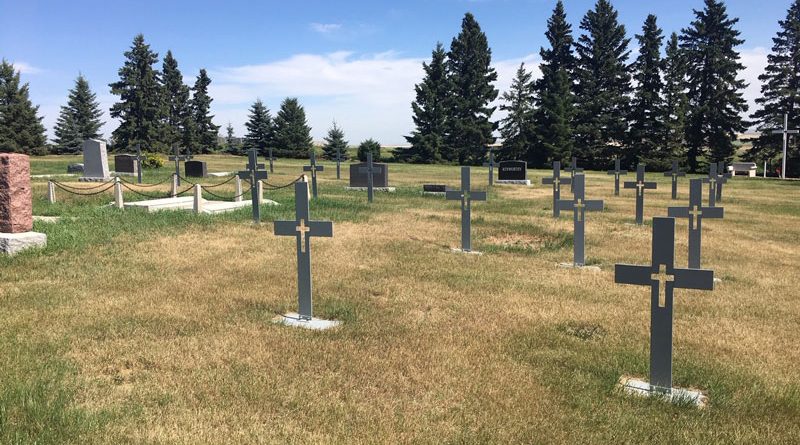It’s a prairie cemetery
By Linda Jensen Times Contributor


Linda Jensen Photo
A rural Rockyford farmer and gardener, Mary Marshman, may have the answers to these questions.
“There is a little prairie cemetery located northwest of Rockyford on a beautiful hill where you can see for miles,” said Marshman. “It is the Rockyford municipality’s cemetery and its restoration was a long time coming.”
About 20 years ago, Merle Marshman asked his sons Gerald and Dwayne, and Dwayne’s wife Mary, to start mowing the grass there. Many Marshmans had settled in the area around and after 1909, and many family members are buried there. Although Dwayne’s great-grandfather passed away in Canada, he was buried in Washington. This was common practise at the time, due to the ease of passenger trains.
And so, the upkeep began.
“Our family mowed according to the rains,” recalls Mary Marshman. “The traditional concrete cemetery markers were old, uneven and hard to mow around.”
Over a decade later, Dwayne and Mary were inspired on a trip to Rocky Mountain House where they visited the beautiful and historical Nordegg Cemetery and wondered, “wouldn’t it be fun to restore the cemetery in Rockyford?”
Their dream had begun.
The Rockyford Union Cemetery restoration started when they acted on that dream. They made a plan and found people to help them fulfill it.
“More than 10 years ago, we put a fence around the cemetery to keep out the cattle,” Mary said. “We got the village on board, and although our resources were limited, we just stepped back and let it happen.
“People donated trees and we planted them. We weed whipped, sprayed for weeds and did general maintenance,” she added. “In order to honour the people buried there, we had to somehow mark their sites. And so, the village had it surveyed. We did not know who was buried where. Some were babies. Pneumonia was prevalent. Medical services were limited, and people were poor (so not marking the gravesites is understandable).”
The Marshman’s found a restoration company willing to help to preserve the burial site to a historical cemetery. Over a few years, their job was to substitute broken cement, level the dirt and replace the headstones.
“What really matters now is that 26 of the 30 unmarked gravesites are now named, and all 30 of them are marked,” said Mary. “We must remember our heritage and honour those people. It is important to recognize their hardships. To have lost your child, or to be in such a place that you had to move on from such an isolated farming community, when you lived in buildings where the water froze. People had to survive, to grow crops to feed their families. The dream to own your own place and pass it down was a real one.”
The restoration of the graveyard would not be possible without the help of the Western Irrigation District and volunteers who installed drip irrigation lines and a riser. As well, donated items include metal crosses, a 26-name plaque, two concrete benches and a large white cross. The actual cost of the restoration was all in donations of time, ideas, energy, supplies and labour.
At Rockyford’s centennial celebration this summer, the Union Cemetery was recognized, quietly admired and celebrated. Among the many visitors there that day was an unknown gentleman who stood back with his hat in his hand. Later, he confronted Mary Marshman.
“Thank you,” he said simply. “My uncle is buried here. Thank you for caring for his grave all these years.”
Marshman recalls those words with genuine surprise.
“Who knew what kind of impact the cemetery refurbishment would have on others?”
Rockyford Union Cemetery is home to loved ones remembered and to family histories. A sitting area overlooks graveyard markers that honour the lives of Alberta homesteaders. When Marshman thinks of all the love and work that has contributed to the cemetery’s historical upgrade, she remembers a conversation with her late husband, Dwayne.
“We should cut the grass more,” she told him. And with a twinkle in his eye, Dwayne disagreed, saying, “it’s a prairie cemetery.”
